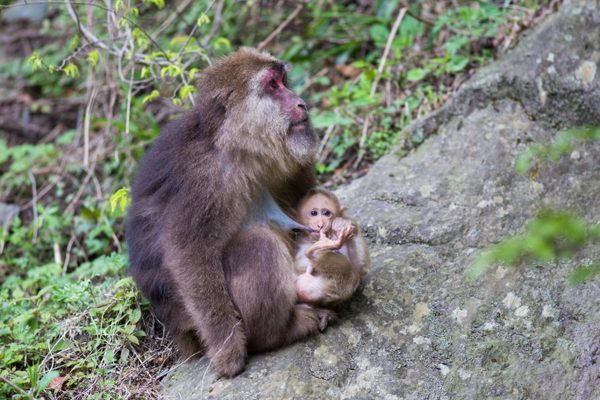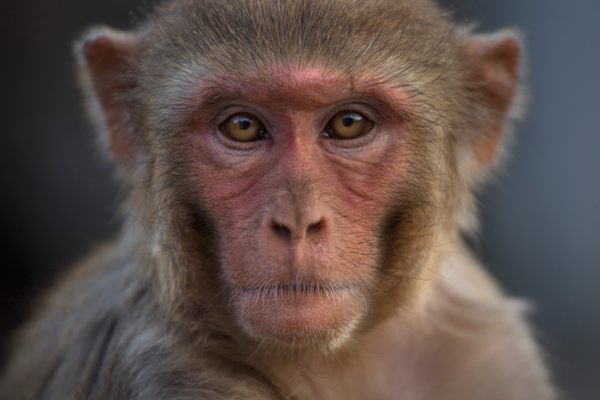Is Dr. Seuss’s Lorax Real?
New research suggests the creature is based on a particular monkey that the writer encountered in Kenya.

Oho! Lookie here! What do you suppose!
An article penned in pedestrian prose.
If you would prefer something different, dear reader,
Click here for a version in Seussian meter.
In 1970, Theodore Geisel was suffering from terrible writer’s block. Geisel, better known to most of us as Dr. Seuss, had just organized with his neighbors in California to prevent the destruction of a grove of eucalyptus trees. Fired up by this experience, he was attempting to pen an environmentally minded children’s book. But everything he tried to read for inspiration, he later said, was “dull,” “full of statistics,” and “preachy.”
In autumn, to get his mind off things, his wife Audrey took him on a trip to the Mt. Kenya Safari Club, on the Laikipia Plateau. The change of scenery worked: One day, after he watched a herd of elephants cross the peak, “the logjam broke,” Geisel later wrote. “I wrote 90% of [The Lorax] that afternoon,” on the side of a laundry list.
We hold certain Seuss characters to be self-evident. Yertle is a turtle. The Cat in the Hat is a haberdashery-inclined feline. Mayzie is a lazy bird. Others, though, are more mysterious. A few pages into The Lorax, we are given a couple of framing questions. “Who was the Lorax?” the narrator asks. “And why was it there?”
Recently, a group of researchers revisited this query, and came up with a unique answer. The Lorax, they posit, is not entirely invented, like Sam I Am or Things 1 and 2. Instead, it’s inspired by a particular real-life species, a fuzzy-faced primate called the patas monkey that Geisel got to know in Kenya. Their conclusion, a paper called “Dr. Seuss and the Real Lorax,” was published in Nature Ecology & Evolution earlier this week.

Like many interdisciplinary efforts, this reexamination of the Lorax began at an academic dinner with assigned seating. Nate Dominy, a biological anthropologist, was put next to Donald Pease, a literary scholar. “He’s one of the most famous and popular professors on campus, [and] sitting next to him was really intimidating,” says Dominy. “I was desperate for something to talk about.”
Pease is a world expert on Theodore Geisel, a.k.a. Dr. Seuss. So Dominy started telling him about the patas monkey. “It’s a funny-looking monkey,” he says. “When I’m introducing it in class, I always say, ‘If Dr. Seuss were to create a monkey, that would be the one.’ It looks ripped off the pages.”
Pease told Dominy about Geisel’s trip to Kenya, at which point Dominy realized exactly which Seuss character the patas monkey looks like. “Once you have a mental image of the Lorax and the patas monkey side-by-side in your head—wow, there’s something there,” he says.

Let’s go to the tape. The Lorax is, in the words of the Once-ler, “shortish, and oldish, and brownish, and mossy.” He’s got a small black nose, skinny arms and legs, and a giant bush of a mustache that covers his entire face. The patas monkey looks quite comparable, with orange fur, wiry limbs, and his own lush crop of facial hair.
There are also sonic similarities: the Lorax’s voice is characterized as “sharpish and bossy,” and at one point he lets out a “sawdusty sneeze.” This could reasonably describe the wheezy alarm call of the patas monkey, the researchers say. (There are differences, too: the patas happens to be the world’s sweatiest primate, while the Lorax is able to lift himself up by the seat of his pants and fly away.)
Not content to speculate, and determined to take advantage of the best technology on offer, Dominy and Pease then partnered with a couple of other researchers and ran the Lorax through a face-analyzing computer algorithm. “There are 13 images in the book where the Lorax is facing the reader,” says Dominy. “We photographed all 13 of these faces and made a composite.”

According to the paper, the computer found that “the Lorax is better characterized by primate face space than even the most similar-looking Seussian character”—in this case, the cheerful orange hero of 1967’s The Foot Book. Specifically, “the face of the Lorax clusters closely with three species,” one of which is the patas monkey. “The coincidence seems striking,” the authors write.
It’s certainly exciting to imagine the Lorax joining the pantheon of environmentally conscious famous monkeys rather than languishing in his current one, of environmentally conscious famous mythical creatures. But this species switch may have bigger implications, too. For Pease, the most important part of the comparison rests in the patas monkey’s entanglement with a nearby plant, the whistling thorn acacia tree. The two species have a commensal relationship: about 50 percent of the patas monkey’s diet comes from acacia gum, which the monkeys eat without harming the tree.
“This addressed a problem that I had with usual readings of The Lorax,” says Pease, namely the Lorax’s use of the possessive pronoun “my” (as in “my poor Swomee-Swans” or “what’s that THING you’ve made out of my Truffula tuft?”).
Others have noticed this, too. “There are ecocritics who have produced commentary in which they question the language used by the Lorax in order to defend the Bar-ba-loots and the Swomee-Swans and the Humming Fish from the ax of exploitation and extraction,” Pease explains. “If he’s simply protecting the property, how can he be differentiated from the capitalist or the resource extractor that he’s opposing?”

If, instead, the Lorax is part of the land, this “my” makes much more sense. “The patas monkey has an intimate relation with the acacia tree,” says Pease. “Which means that it could say what the Lorax says: ‘I speak for the trees.’”
It might also affect how environmentalists see the character, Dominy says. In 2011, journalist Emma Marris called the Lorax a “parody of a misanthropic ecologist,” always yammering on. If, instead, he’s a monkey, “that really does change things,” says Dominy. “His anger is now understandable … we don’t usually hear the voices of the creatures going extinct.”
Starting in the mid-1980s, conservationists began leaning on particularly charismatic animals, called “flagship species,” to represent their entire environments. If you read the Lorax as a patas monkey, Dominy says, you might consider him “the original flagship species.” (In this case, the Truffula tree might be the original keystone species.)
Pease doesn’t want to take this too far. “To say, everyone who reads the Lorax is supposed to have the patas monkey as the sole referant—no,” he says. “That reading is too literalist.” But keeping the monkey in mind can enrich our experience, both of the book and the world that inspired it. And, with this settled, we can finally begin searching Scandinavia for the original Grinch.
But wait. Something’s missing. The spirit of Seuss. Take two on this story—of much greater use:
We’ve all read The Lorax like 12 million times.
It’s got a good message, and also, it rhymes.
But I’m in a spirit of sincere confiding,
and there is a secret the book has been hiding.In the earliest pages of this sad affair,
We’re asked “What was the Lorax? And why was it there?”
I’ll float you a theory intriguing and funky.
The Lorax—researchers have found—was a MONKEY!The monkey’s full name? Erythrocebus patas.
It enjoys, at the moment, an unthreatened status.
It lives across Africa, in the savannas
And eats bugs and tubers (not so much bananas).It’s got a big mustache and bright orange fuzz,
The same exact look that that Lorax guy does.
Each of these creatures is crazy for trees.
When frightened, both let out a “sawdusty sneeze.”What’s more, Dr. Seuss almost certainly spied him
While on a vacation in Kenya’s vast highlands.
It’s settled. So certain, in fact, that I’m bored.
The evidence here just cannot be ignored.Oh, you don’t believe me? You couldn’t be ruder!
What are you, a Once-ler? Let’s ask a computer.
This graphic of primate-based face recognition
Will surely dry up your last dregs of suspicion.You’re still not convinced? Why, you dumb Bar-ba-loot!
Let’s talk of his language. Come on, be astute.
When speaking, he uses possessives with ease
Like “My Swomee-swans” and “My Truffula trees.”Is the Lorax, at heart, a resource-extractor?
Oh no! Surely not! That would be a disaster!
He’s speaking, instead, with an inclusive bent.
He must be a part of the en-vi-ron-ment.You question me still? May you choke on your thneed.
There’s one last remonstrance it seems you might need.
Critics call the Lorax a whiner and nag.
But if he’s a monkey—that isn’t as bad.So next time you open this book illustrated
Please think of the case I have here demonstrated.
Academics have proven the Lorax is simian.
(Next up: IS THE GRINCH A MEAN, HAIRY AMPHIBIAN?)











Follow us on Twitter to get the latest on the world's hidden wonders.
Like us on Facebook to get the latest on the world's hidden wonders.
Follow us on Twitter Like us on Facebook